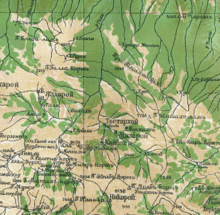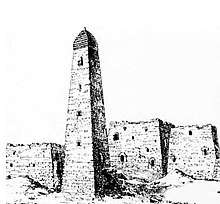Khaibakh, Chechnya
Khaibakh (Chechen: Хьайбаха), (Russian: Хайбах), also spelled Khaybakh, is a non-residential village in Galanchozhsky District, Chechnya.
Administrative and municipal status
Municipally, Khaibakh is incorporated into the Galanchozhsky District. Until 1944, it was the administrative center of the Khaybakhoyskoye rural locality. However, at present - it is not organised into a rural locality.
Location

Khaibakh is located in the center-east of Galanchozhsky District, on the left bank of the Gekhi River. It is located 5 kilometres (3.1 mi) east of Galanchozh and 56 kilometres (35 mi) south-west of Grozny.
The nearest settlements to Khaibakh are Yalkhoroy in the north-west, Galanchozh in the west, and Charmakha in the east.[1]
History

On the doorway of the teip (clan) tower in the village, there is a petroglyph in the form of a human hand, palm down.[2]
In 1990, there was a plan to build a large memorial to the massacre at the site of Khaibakh, with a special fund set up to raise money. However, this was disrupted by the First and Second Chechen Wars, and the memorial was never built.[3] In 2019, it was announced that the memorial would be built.
In 2008, Ramzan Kadyrov described author Stepan Kashurka as a "hero", who "wrote in his book the truth about the tragic fate of the mountain village of Khaibakh". As a result, 200,000 rubles were set aside in the Akhmat Kadyrov fund to build a monument to Kashurka.[4]
In 2019, Khaibakh was named as one of the first 7 settlements in Galanchozhsky District to be rebuilt in order to resettle the area.[5]
Khaibakh Massacre
On 27 February 1944, the residents of the village of Khaibakh fell victim to the genocide and deportation of the Chechen and Ingush people by Soviet troops. However, it was snowing on that day in the mountains, including in Khaibakh. As a result, the Soviet troops told residents in Khaibakh and nearby auls (villages) that they could come to Khaibakh's stable while an alternative transport route was set up for them. However, the stable, full of straw, was locked when more than 700 people, who could not descend from the mountains, were inside. The stable was then set ablaze, with anyone who escaped the burning structure being shot. The village has since become notorious for the massacre.
Ruins
As of 2019, there are still several standing buildings in Khaibakh; the teip (clan) tower, a military tower, two former residential towers, and a newly constructed mosque.[6][7] However, due to Russian military exercises in the area around Khaibakh between 2005 and 2007, the teip (clan) tower was partially destroyed. As a result, only the lower half of the structure remained standing, until it was fully restored in November of 2019.[8] The foundations of numerous houses also remain in the village.
Media
The massacre in the village was depicted in the film "Ordered to Forget". However, this film was banned in Russia due to "insufficient evidence" to prove that the massacre, an event that is denied by the Russian government, ever happened.[9]
References
- "Карта Чеченской республики подробная с районами, селами и городами. Схема и спутник онлайн". 1maps.ru.
- "Религиозная культура чеченцев с древнейших времен до нашего времени — Нохчалла.com — Чечня, чеченцы, обычаи, традиции, история и многое другое" (in Russian).
- "Еще раз о трагедии Хайбаха. Часть вторая". www.voinenet.ru. Archived from the original on 2019-05-12. Retrieved 2019-05-12.
- "Президент ЧР Р. Кадыров встретился с вице-премьером Л. Магомадовым". chechnya.gov.ru. Archived from the original on 2013-05-23. Retrieved 2019-05-12.
- Узел, Кавказский. "Власти Чечни отрапортовали о более чем 6500 желающих переехать в Галанчожский район". Кавказский Узел. Archived from the original on 2019-05-11. Retrieved 2019-05-12.
- "Памятники истории и культуры (объекты культурного наследия) народов Российской Федерации". Archived from the original on 2016-03-01. Retrieved 2019-05-12.
- Kosumov, Lom-Ali. "В восстановленной мечети селения Хайбах прозвучал первый азан после долгого молчания". ЧГТРК "Грозный".
- Kosumov, Lom-Ali. "В селении Хайбах после реставрации открыли одну боевую и две жилые башни". ЧГТРК "Грозный".
- "Russia bans 'historically false' film on Stalin deportations of Chechens". AsiaOne. May 27, 2014.